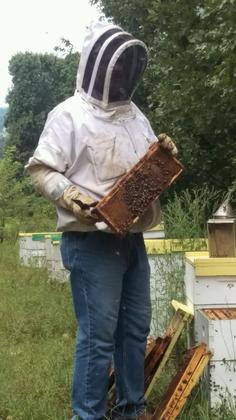
Faces and Places: Bee Farming in the Ozarks
People often have a fear of bees and yes, to some, they can be scary creatures, but once you begin to learn about them you realize how fascinating they are.
Bees and their colony are more complex than one may realize. When talking with local honey farmers, one realizes how complex and dedicated these little insects are. They have an intricate system that helps them to thrive and produce honey.
August 26, 2015 | Source: Area Wide News | by Renee Janes
People often have a fear of bees and yes, to some, they can be scary creatures, but once you begin to learn about them you realize how fascinating they are.
Bees and their colony are more complex than one may realize. When talking with local honey farmers, one realizes how complex and dedicated these little insects are. They have an intricate system that helps them to thrive and produce honey.
A bee colony consists of three kinds of bees: workers, drones and the queen. Worker bees clean the hive, take care of the brood and the eggs and raise the young bees. The last job the bee has is to forage for pollen and nectar. The elders of the bees are the ones sent out to gather the honey. The average lifespan of a worker bee is 21 days during the summer and approximately three to six weeks in the winter. However, the exception to the rule is queen bee. She can live approximately four to seven years.
“The worker bees are female and the drones are males and service the queen. Worker bees take care of the queen and direct her to where she needs to go. They dictate to her sometimes what she is supposed to do and her main function is to lay the eggs,” said Mark Hoover, owner of a honey farm located just outside of Mammoth Spring, Ark. Hoover has been honey farming for approximately four and a half years. He has approximately 150 to 160 bee hives. His in-laws were previously involved in honey farming and this is what has lead him to this practice. They had been bee farming approximately seven to eight years before Mark joined them.
The size of the cones in the hives dictate what the bee will be as the drone cone and worker bee cone are two different sizes. At the end of the season most drone bees are driven out of the hive and are left to die. And they restart the process. When the bees realize they need a new queen they will make a new queen cell by taking one of her eggs and keep the queen away from it. If the queen knows the new one exists she will kill it by stinging it.
When asked what was most interesting about being a beekeeper and honey farming Hoover said, “It’s neat to see how a colony survives and all of the different functions in the colony, every bee has a role. The babies take care of the brood and the eggs. As they get older they graduate to cleaning the hive and as they continue to get older they go out and become foragers.”
When extracting honey, “each hive is different. Some are strong and some are not so strong and different ages. An average pull on a super is about 40 pounds of honey and we do that about twice a year when the honey is capped. Once after the spring and again in mid-summer or the last part of summer,” said Hoover.
“We do pollination in California for the almond blooms. They sit in the blooms for roughly three weeks to a month, depending on how long the blooms last and when they are done we pull them out. The farmer pays us so much a hive for setting our bees in there. As long as the blooms are there the bees can work and after the blooms are gone, the bees are pulled,” said Hoover of one part of the pollination process.
